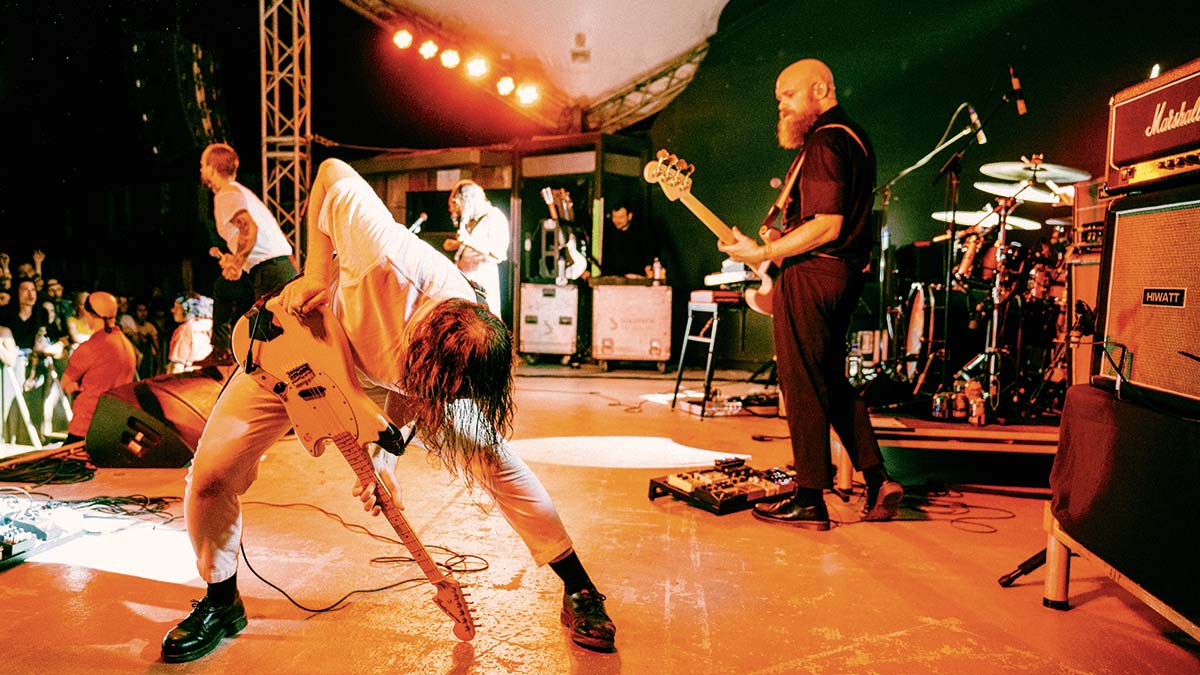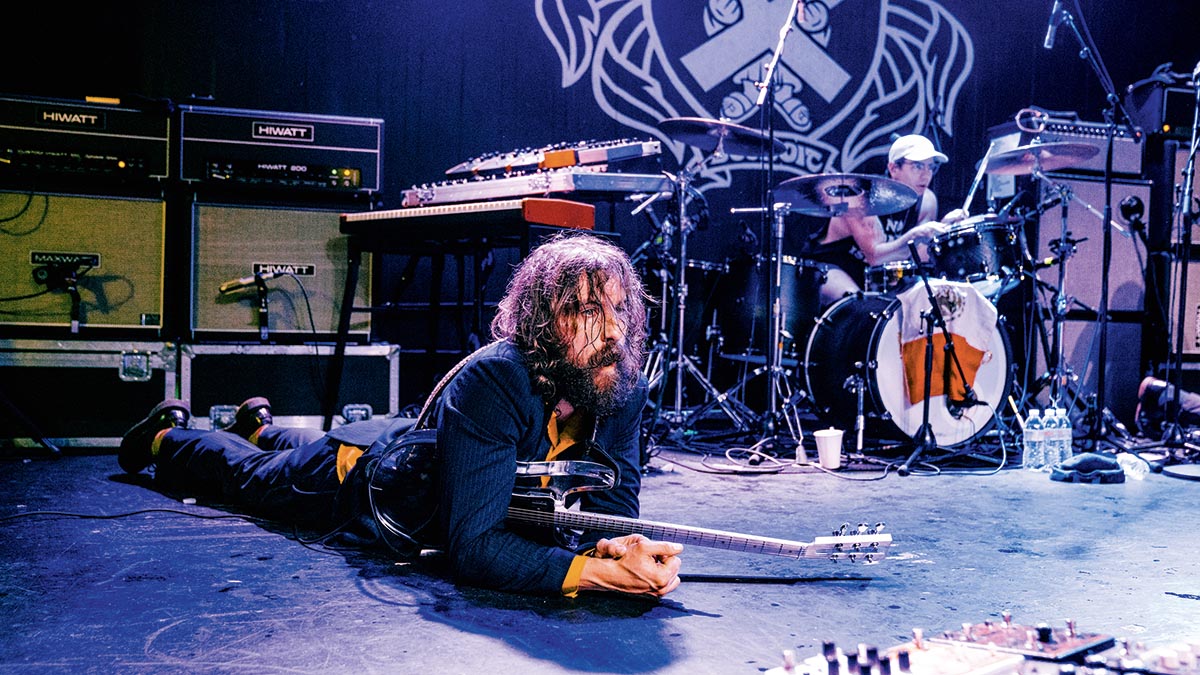IDLES: “The ability level of what we do is not out of reach of anyone. That’s the best thing. It’s just the use of pedals, the sonics and the timing”
Guitarists Mark Bowen and Lee Kiernan unpack the breathtaking sonic evolution of the world's most innovative post-punk band and share the secrets of their pedalboards

Most of us would be happy never to hear the word ‘lockdown’ again, but the UK’s most exciting guitar band have made the best out of a bad situation. Forced to abandon their usual approach to writing, IDLES found a new way of working - and discovered entirely new sounds in the process. The result is a brilliant new album, Crawler.
Less than a year since Total Guitar spoke to them about the hit album Ultra Mono, guitarists Lee Kiernan and Mark Bowen are back with even bigger pedalboards and an even more ambitious sound. But this story starts with the band’s members scattered across the globe, separated by Covid-19.
“We had to write it with everyone off in different places,” says Mark, simply. “Normally we write in a room together, and you have to impress four other people with something loud and brash. This time, you were able to sit and work on something until you got better at it. You didn’t have to be good at it right away. There are arpeggios and things like that that I’ve never done before. And we used production as a tool in songwriting, not just playing the guitar.”
Those two new elements – musical subtlety, and making production techniques integral to the songs – have produced something entirely new. Mark is animated as he explains the journey.
“Ultra Mono was all about the context of playing live – big bangs that can reverberate around the room. This time we were writing music that only lived in playback, in whatever recorded medium. That meant things got smaller but lighter. Up until this point intricacy and nuance weren’t there. IDLES was always about expression through violent movement.
“Now I get the feeling of expression through subtle changes in pick action, subtle changes in tone. I did a lot of guitar synthesis on this album, like subtle filter sweeps that take a whole song to finish. It’s almost the polar opposite of Ultra Mono.”
Lee gives an example: “The most violent thing I do on this whole album is the bridge in Car Crash, and I barely move my body. I am the most static yet violent-sounding I’ve ever been. It’s just a tiny, tiny filter sweep with my foot, that’s all.”
Get The Pick Newsletter
All the latest guitar news, interviews, lessons, reviews, deals and more, direct to your inbox!
Lead single Car Crash embodies the creative vision for the album. “It’s like everything we were trying to do with Ultra Mono, but we actually did it,” Mark says. “It’s a noise-rock/hip-hop song and I don’t think you can recognise guitars in it. There’s no synths on that song. There’s no synths anywhere on the album – well, there’s one synth and it really pisses me off!
“On Ultra Mono, we were trying to do this, like, hip-hop thing, but the first thing you would hear is that this is a band. If you listen to Car Crash or MTT 420 RR, you’re like, ‘Is that guitars?!’”
You could describe the Crawler Machine as a modular synth where the guitar is the primary oscillator
Mark Bowen
The synthetic sounds are indeed all guitars, though. As Mark explains: “There’s a lot of looping going on.” The guitar parts were recorded directly into the computer and cut into loops. Those were sent back out into a specially built pedalboard known as the ‘Crawler Machine’, designed by Mark’s tech Gavin Maxwell. “I guess you could describe it as a modular synth where the guitar is the primary oscillator,” Mark says.
Three loop stations allow Mark to make loops both pre- and post-effects, and a GigRig G3 switcher lets him change the order of pedals on the fly. Core sounds are the Moogerfooger Freqbox, Ring Modulator, and Cluster Flux pedals, connected via Moog’s CP251 modular synth controller.
There’s also an Electro-Harmonix POG, the ElectroLobotomy Particle Smasher (a synth noise generator which also accepts guitar signals), and a delay. This fearsome array makes it (just) possible to recreate Crawler live.
“I had these guitar loops going through,” Mark says. “Then it was lots of knob twiddling and that’s how we ended up with the song MTT 420 RR, and a similar thing for Car Crash. We’ve had to work out how to play it live, and it’s weird – we can!”
Not to be outdone, Lee’s pedalboard has doubled in size since last year. “The whole point was to be a writing 'board,” he says. “I had a reverb at the beginning and at the end, two tremolos, an expression pedal, a Whammy pedal, and then a harmoniser for double octave capabilities.
“The problem with all that crap is that it ended up having to come out on tour because things were written for this pedalboard. It has to stay a double fucking pedalboard. It’s so large it’s really not economically viable. There’s certain songs it’s really difficult to actually change sections because the pedals are so far apart from each other you can’t do it in time.”
The defiantly old-school Lee is going to add a GigRig G3 to facilitate patch changes. “No-one told me before that I could turn eight pedals on and off at once! That seems like key information that I should have been told. It’s really sick. Within about 10 minutes of Bowen having one I was like, ‘Well, I need one of those.’”
Making Crawler an entirely studio-based project meant the band were unrestricted by concerns of what they could pull off live, and some songs have multiple guitar tracks. Despite this, fans at their recent US tour have seen that the songs do work live.
“They’re translating really well,” Mark smiles. “We’ve done Progress in a live session. It’s the hardest thing I’ve ever done because I have to set up [the loops]. I’m playing a different part of the song to the rest of the band, and then I’m responsible for something with my right foot, something different with my left foot while moving knobs or remembering to go back to play the guitar. It’s really hard work! It’s a very different beast to jumping up and down and running around on stage. There’s a lot more thinking to do.”
Lee agrees: “The new songs don’t quite feel natural performatively yet. All the other albums were played live so often like, even before they came out, that it was just like ready to perform. Now even though we’ve played these songs on repeat in a practice room, we’re on in-ears now and we’re playing to click all the time, concentrating, and it’s just so different. It doesn’t feel like I have to dance around. I feel like I just really want to know the song and really enjoy it.”

As Mark puts it: “The musicianship has become the means of expression rather than the performance. Now it’s about actually if we nail this, we all lock in and get this song sounding the way that we want it to, that’s the performance in itself. We’re real musicians now!”
But despite this newfound intricacy, says Lee, “The ability level of what we do is still not out of reach of anyone. That’s the best thing. You don’t have to be a super-amazing player to play anything we do. It’s just the use of pedals, the sonics and the timing.”
When we interviewed Mark and Lee about Ultra Mono, they described the evolution of their playing. On their debut, Brutalism, they both played constantly without really listening to each other. By Joy As An Act Of Resistance, this had evolved into each guitarist playing off what the other was doing. For Ultra Mono, they frequently played the same parts together for power.
This time, says Lee, “We’ve gone back to the sort of realms of Joy where we do play off each other, except we’ve learned from making three of those albums. All the things we wanted to do before we’re actually able to do. There’s stuff that we still want to do that is completely within our grasp now, because we’re starting to understand each other. It’s taken four albums!”
Even though we’re on a click for some of the songs, the thing that makes us loose is not the timing, it’s the playing
Lee Kiernan
Conceived as a studio project, Crawler features many layers of multi-tracks, and it wasn’t always clear how it could be done live. Backing tracks, though, were out of the question. Says Lee: “We had many conversations about how to play this live and how no-one really wanted to play to backing tracks because it goes so far against the way we perform. We want to be a bit loose at times, and the only way to be loose is to actually play things.
“Even though we’re on a click for some of the songs – for loops and stuff – the thing that makes us loose is not the timing, it’s the playing. Bowen is always looping things slightly different every time he does it. It keeps it real. If we were playing to a backing track I just don’t see us being happy.”
Despite all the electronic elements, for amps Lee and Mark remained resolutely old school. “We built an enormous wall with every single amp that we have,” Lee explains, “and moved the microphones around whenever we needed them.”

Where the guitars on Ultra Mono were a blend of up to three amps each, for Crawler the band looked carefully at which frequencies were needed for each part, and chose amps specifically for the job.
They worked tirelessly with combinations of mics until the recorded guitar sounds captured the sound of the amps in the room. Lee used primarily a Marshall Plexi, Fender Twin, and WEM ER-40, while Mark used a Hiwatt DR103, and a Hex Micro T preamp (which recreates the sound of the legendary Sunn Model T) into an Orange AD200 and 2x15 cabs, to cope with the thunderous low-end of his baritone guitar.
For guitars, Mark again relied on his custom Fender baritone and aluminium-necked EGC, while Lee found himself with, most shockingly of all, a brand-new guitar. “Fender gave me the American Professional II Telecaster. Within 20 seconds, that guitar just created a song, When The Lights Come On. That became the guitar I primarily used because it had such versatility and such a warm sound we’d been looking for.”
You can learn how to make insane music by just getting your hands on a DAW. I think that the more we dinosaurs in rock bands embrace that, the more progressive we will become
Mark Bowen
Last time we met, Mark was at pains to stress to musicians that it isn’t necessary to spend a fortune on gear to get creative tones like the ones on Ultra Mono. But the same can hardly be said of Crawler, dependent as it is on entirely custom rigs.
“I’m not going to pretend that you can make the sounds of my rig,” he says. “The Crawler Machine is prohibitively expensive even for us to go out on tour. It requires a constant tech because neither one of us has the ability to fix anything that fast.
“Don’t worry,” he laughs, “I’m still in love with standing in front of a wall of amps and turning everything to 10. But there’s a crazy amount of creative scope out there. If I was starting off as a musician I would be less interested in getting my hands on a Fender Stratocaster than getting my hands on a laptop and an audio interface.
“From forums and YouTube you can learn how to make insane music by just getting your hands on a DAW. I think that the more we dinosaurs in rock bands embrace that, the more progressive we will become. It’s the new rock and roll, and I think that there’s scope to be both. Hopefully that’s what Crawler is.”
- Crawler is out now via Partisan.
“The main acoustic is a $100 Fender – the strings were super-old and dusty. We hate new strings!” Meet Great Grandpa, the unpredictable indie rockers making epic anthems with cheap acoustics – and recording guitars like a Queens of the Stone Age drummer
“You can almost hear the music in your head when looking at these photos”: How legendary photographer Jim Marshall captured the essence of the Grateful Dead and documented the rise of the ultimate jam band








![John Mayer and Bob Weir [left] of Dead & Company photographed against a grey background. Mayer wears a blue overshirt and has his signature Silver Sky on his shoulder. Weir wears grey and a bolo tie.](https://cdn.mos.cms.futurecdn.net/C6niSAybzVCHoYcpJ8ZZgE.jpg)

